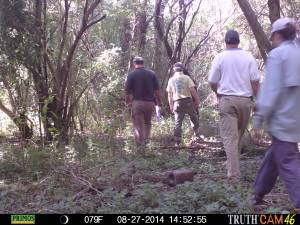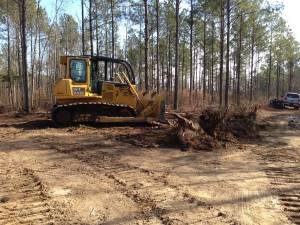We have been fortunate to get lots of professional input into our land management, from state, private, and NWTF foresters along with NRCS officials and state biologists.  It was pretty much a universal opinion that our first goal was to do a controlled burn of the forest areas. Needless to say, we needed a lot of education about this as the thought of setting fire to our woods was scary, if not outright frightening. So, the knowledge search was on! It is actually a quite interesting topic (and one that is somewhat timely given the bout of forest fires in the western US). Throughout time, the pine forests of the southeast have become interdependent with frequent low temp burns, usually initiated by lightning strikes. This is especially true for Longleaf pines. Modern attempts to control forest fires have been to this woodland ecosystem’s detriment.
It was pretty much a universal opinion that our first goal was to do a controlled burn of the forest areas. Needless to say, we needed a lot of education about this as the thought of setting fire to our woods was scary, if not outright frightening. So, the knowledge search was on! It is actually a quite interesting topic (and one that is somewhat timely given the bout of forest fires in the western US). Throughout time, the pine forests of the southeast have become interdependent with frequent low temp burns, usually initiated by lightning strikes. This is especially true for Longleaf pines. Modern attempts to control forest fires have been to this woodland ecosystem’s detriment.
For us, there were four main reasons to burn:
- Safety: There was a lot of woody debris (known as “slash” in logging terms). This coupled with a heavy layer of pine straw and leaves made us at high risk for a hot, uncontrolled wildfire sparked by lightning or a careless discarded cigarette.
- Nutrient recycling: The burning of woody debris to ash releases stored nutrients. Since wood ash is from plant material, it has most of the 13 essential nutrients the soil must supply for plant growth.
- Mulch removal: Landscapers use pine straw mulch to cut down on weed growth in urban landscapes. In woodland terms, these “weeds” are known as native grasses and forbs. These are important for a healthy ecosystem, especially wildlife. Burning reduces pine straw.
- Control of undesired species: Burning cuts down on vegetation of low value such as sweetgum seedlings, invasive species such as chinese privet, and annoying creatures such as chiggers and ticks.
In order to safely burn, the woodland areas must be surrounded by “no burn” areas known as firebreaks. These served us an other purpose by providing more access to our farm.
This is how we met Stick Cameron. If someone could be an artist with a bulldozer, it was Stick. He did in a day and a half what would have taken us years.
Now for the burning. The state foresters will help with controlled burns but their schedule is usually very backlogged. We had developed a relationship with a private forester (we needed a timber appraisal to establish a cost basis for taxes), so we arranged with him to help with a burn. It took us well over a year until the weather and timing were right for a low, temperature controlled burn.
[vimeo 138768191 w=284&h=160]
[vimeo 138775485 w=284&h=160]
We were able to get the first part burned on Superbowl Sunday 2015. It was exciting.


Am enjoying your recent updates.